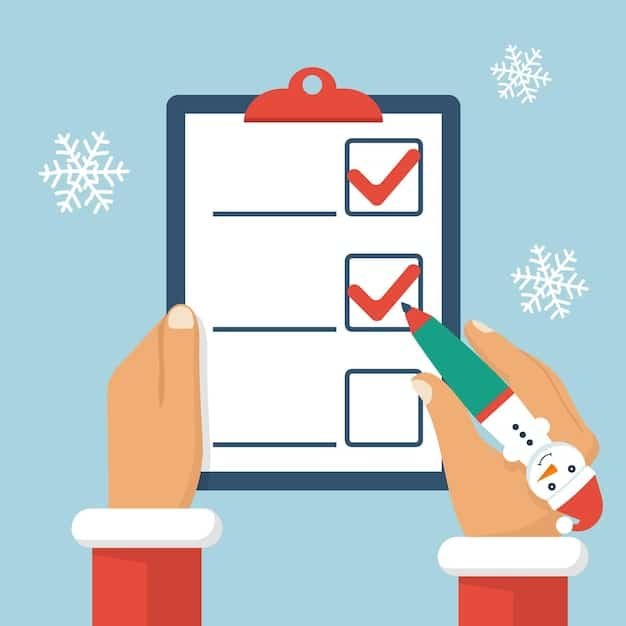Debt Forgiveness Programs: Requirements and Application (Jan 2025)

Debt Forgiveness Programs: Eligibility Requirements and Application Process (Updated January 2025) provide pathways for individuals to alleviate their debt burden by meeting specific criteria and completing an application, offering financial relief and a fresh start.
Navigating the complexities of debt can be overwhelming. Understanding Debt Forgiveness Programs: Eligibility Requirements and Application Process (Updated January 2025) can be a crucial step towards financial recovery.
Understanding Debt Forgiveness Programs in 2025
Debt forgiveness programs are designed to help individuals and families struggling with overwhelming debt. These initiatives offer a way to reduce or eliminate outstanding debt, allowing people to regain financial stability. In 2025, several programs are available, each with its own set of requirements and application processes.
It’s essential to understand the different types of debt forgiveness programs to determine which one best fits your situation. From federal student loan forgiveness to debt relief options for small business owners, exploring these options can provide a path toward a debt-free future.
Types of Debt Forgiveness Programs
Several types of debt forgiveness programs exist, catering to different kinds of debt and financial situations.
- Federal Student Loan Forgiveness: Programs like Public Service Loan Forgiveness (PSLF) and Income-Driven Repayment (IDR) forgiveness offer relief to borrowers with federal student loans.
- Medical Debt Forgiveness: Some hospitals and non-profit organizations offer programs to forgive or reduce medical debt for eligible patients.
- Credit Card Debt Relief: While not technically forgiveness, debt settlement and debt management plans can help reduce the amount owed on credit card debt.
- Small Business Debt Relief: The Small Business Administration (SBA) offers programs to assist small businesses struggling with debt, including loan forgiveness and debt restructuring options.
Understanding these different types of programs can help you identify the best route for your financial situation. Always research eligibility requirements and application processes thoroughly.
Eligibility Requirements for Debt Forgiveness
Each debt forgiveness program has specific eligibility requirements that applicants must meet. These requirements often vary depending on the type of debt, the lender, and the specific program. For example, federal student loan forgiveness programs may require borrowers to work in public service or make a certain number of qualifying payments.
Meeting these requirements is crucial for securing debt forgiveness. Failure to meet all eligibility criteria can result in denial of the application. Therefore, it’s important to carefully review the requirements of each program before applying.

Key Eligibility Factors
Several factors can influence your eligibility for debt forgiveness programs.
- Income Level: Many programs have income thresholds that applicants must meet to qualify.
- Employment Status: Some programs, like PSLF, require specific employment in public service or non-profit sectors.
- Type of Debt: The type of debt (e.g., student loan, medical debt) will determine which programs you are eligible for.
- Repayment History: A history of on-time payments may be required for certain programs.
Carefully assessing these factors can help you determine your eligibility for different debt forgiveness programs. It’s also a good idea to gather all relevant financial documents to support your application.
Application Process: A Step-by-Step Guide
The application process for debt forgiveness programs can be complex and time-consuming. However, understanding each step can increase your chances of a successful application. Typically, the process involves gathering necessary documents, completing the application form, and submitting it to the appropriate agency or lender.
Following the application process carefully and providing accurate information is essential. Errors or omissions can lead to delays or denial of your application. Therefore, it’s crucial to pay close attention to detail and seek assistance if needed.
Navigating the Application Steps
Here’s a step-by-step guide to help you navigate the application process:
- Research Programs: Identify the debt forgiveness programs you are eligible for and gather information about their requirements.
- Gather Documents: Collect all necessary documents, such as income statements, tax returns, and loan documents.
- Complete Application: Fill out the application form accurately and completely.
- Submit Application: Submit the application to the appropriate agency or lender by the specified deadline.
- Follow Up: After submitting the application, follow up to ensure it has been received and to address any questions or concerns.
By following these steps carefully, you can increase your chances of a successful debt forgiveness application.

Common Mistakes to Avoid in Debt Forgiveness Applications
Applying for debt forgiveness can be a complex process, and it’s easy to make mistakes that can jeopardize your application. Avoiding common pitfalls can significantly increase your chances of success.
Some of the most common mistakes include submitting incomplete applications, providing inaccurate information, and missing deadlines. Understanding these errors and taking steps to avoid them is crucial for a smooth application process.
Key Mistakes to Watch Out For
Be aware of these common mistakes:
- Incomplete Applications: Ensure all sections of the application are filled out completely and accurately.
- Inaccurate Information: Double-check all information provided, including income, employment details, and loan amounts.
- Missed Deadlines: Submit your application before the specified deadline to avoid automatic denial.
- Lack of Documentation: Provide all required documents to support your application.
Avoiding these mistakes can help ensure your application is processed smoothly and efficiently. Always review your application carefully before submitting it.
Resources for Debt Forgiveness Assistance
Navigating the world of debt forgiveness can be challenging, but numerous resources are available to provide assistance. These resources can help you understand your options, prepare your application, and navigate the process.
From government agencies to non-profit organizations, a variety of resources can offer guidance and support. Taking advantage of these resources can make the process less daunting and increase your chances of success.
Available Support and Guidance
Consider these resources for help:
- Government Agencies: Agencies like the Department of Education and the Small Business Administration offer information and assistance on debt forgiveness programs.
- Non-Profit Organizations: Many non-profit organizations provide free or low-cost debt counseling and application assistance.
- Financial Advisors: Consulting with a financial advisor can provide personalized guidance and support.
- Legal Aid Societies: Legal aid societies offer free legal assistance to low-income individuals struggling with debt.
Exploring these resources can provide valuable support and guidance as you navigate the debt forgiveness process.
Future Outlook for Debt Forgiveness Programs (2025 and Beyond)
The landscape of debt forgiveness programs is constantly evolving, with potential changes in eligibility requirements, funding, and program availability. Staying informed about these changes is crucial for anyone considering debt forgiveness in 2025 and beyond.
Policy changes, economic conditions, and government priorities can all influence the future of debt forgiveness programs. Therefore, it’s essential to stay updated on the latest developments and adapt your strategies accordingly.
Potential Changes and Trends
Keep an eye on these potential trends:
- Policy Updates: Monitor changes in government policies that could impact debt forgiveness programs.
- Funding Availability: Track the funding levels for different programs, as this can affect their availability.
- Eligibility Adjustments: Be aware of any changes to eligibility requirements that could affect your application.
By staying informed about these trends, you can make informed decisions about your debt management strategies and increase your chances of securing debt forgiveness if it becomes available.
| Key Point | Brief Description |
|---|---|
| ✅ Eligibility | Meeting income and employment requirements. |
| 📝 Application | Complete all sections accurately and submit on time. |
| 📚 Resources | Utilize government and non-profit assistance. |
Frequently Asked Questions
▼
Debt forgiveness is a process where a lender agrees to cancel all or part of a borrower’s outstanding debt. This can provide significant financial relief to individuals and businesses struggling to repay their debts.
▼
Eligibility varies by program but often includes factors like income level, employment status, and type of debt. Federal student loan forgiveness, for example, may require public service employment.
▼
The application process typically involves gathering necessary documents, completing an application form, and submitting it to the appropriate agency or lender. Follow instructions carefully and provide accurate information.
▼
Common mistakes include submitting incomplete applications, providing inaccurate information, and missing deadlines. Double-check all details, gather required documents, and submit your application on time.
▼
Resources include government agencies like the Department of Education, non-profit organizations offering debt counseling, and financial advisors who can provide personalized guidance.
Conclusion
Understanding Debt Forgiveness Programs: Eligibility Requirements and Application Process (Updated January 2025) is crucial for those seeking financial relief. By researching available programs, meeting eligibility criteria, avoiding common mistakes, and seeking assistance when needed, individuals can navigate the process effectively and move toward a debt-free future.





